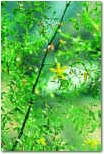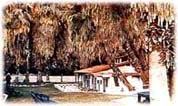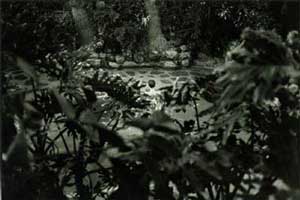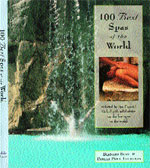TB Puts PS on the Map
There is no question: Tuberculosis put Palm Springs on the map. Up until 1876 when the Southern Pacific Railroad cut through the San Gorgonio Pass to Los Angeles, the area stood virtually undiscovered by white pioneers. Johnny was the first of many invalids to come and be healed in the healthy desert climate. Among the newcomers was a Scottish rancher from Banning, Welwood Murray, who built a hotel across from the McCallum ranch. Murray saw great potential in this key site located next to the Indians' springs.
In 1887, he constructed the Palm Springs Hotel on the corner which now serves as Palm Springs' central downtown intersection, Palm Canyon Drive & Tahquitz Canyon Way, the same corner chosen by Starbuck's sophisticated marketing department for the coffee chain's first desert franchise. Murray leased the springs from the Indians and constructed a makeshift wooden bathhouse above the waters.
Word of the desert's healing powers spread, and Welwood Murray's resort-hotel became a favored "rest home" for patients with respiratory ailments. Across the street stood Lavinia Crocker's Sanitorium, an enclave of tent-houses.
Newcomers Nellie and Dr. Harry Coffman purchased the property in 1909 and opened Dr. Harry Coffman's Desert Inn and Sanitorium: "A modern sanitorium on the edge of the desert with no fogs and no sandstorms," boasted an early brochure. In its first years, the inn catered solely to people suffering from chronic ailments such as asthma and arthritis. Not wanting to be stigmatized by a contagious and socially "unmentionable" disease, the hotel registered guests with TB as having "bronchitis."
Desert Sanctuary
Recognizing the world's pure awesomeness can be medicine for the soul. The late Father Brad Hall, reflecting on the mountain symbolism, referred to the healing power of Psalm 121: "'I will lift up mine eyes unto the hills, from whence cometh my help.'"
While rector of St. Margaret's Episcopal Church, he often took groups to tour the Holy Land. "Western religious theology is loaded with desert symbolism," he remarked after one trip. "Here we're living in a physical world like that of the early Christians and Jews. And the stark mountain landscape, hot springs and dry heat of both deserts have healing powers." Like the hot springs, Mt. San Jacinto is considered a point of power by the Cahuilla.
The Indians revere their desert, believing it to be a constant source of spiritualism. The tribal sweat house was a males-only health center and venue for discussion of important issues. Used both for pleasure and health, sweat baths served as a place for reflection much like the modern sauna and Jacuzzi.
The Desert: Outdoor Pharmacy
Cahuilla women consider the desert a vast repository of food and healing plants. Resourceful herbalists with a thorough understanding of the region's ethno- botany,the women can find sufficient medicines in their own backyard.
 The multipurpose creosote bush (atukul) is one of their favorites. Atukul yields a medicinal tea that tempers colds and sinus problems, a liniment for swollen limbs and arthritis, poultices for healing wounds and preventing infection. Practical cosmetics such as body deodorant and dandruff shampoos also are part of the creosote repertoire.
The multipurpose creosote bush (atukul) is one of their favorites. Atukul yields a medicinal tea that tempers colds and sinus problems, a liniment for swollen limbs and arthritis, poultices for healing wounds and preventing infection. Practical cosmetics such as body deodorant and dandruff shampoos also are part of the creosote repertoire.
Herbalists claim this pungent-smelling bush can cure cancers. Proving these neo-pharmacists right on the money, contemporary researchers are experimenting with creosote as an ingredient in new cancer and AIDS medications.
From Sanitorium to Resort
This wasn't enough for Nellie Coffman. Around 1915, the visionary hotelier decided Palm Springs should become more than just another haven for people who were ill. Her solution was an inn promotion that specified "no invalids," guests afflicted with any communicable disease were not welcome. It worked.
By 1926 the Desert Inn had become a world-renowned hotel, and the desert was now a popular destination for healthier tourists. The biggest attraction was the hot springs. As described by the Indians, the springs "bubble up from great depths through quicksand which washes from her body immediately upon emerging." With a temperature of 104 degrees and a high mineral content, the waters were described as "beneficial in arthritic conditions, skin disorders, overweight conditions, and general nervous disorders."
A May 1909 article in Sunset magazine claimed "All affections of the Skin, Rheumatism, diseases of the Kidneys and Bladder yield readily to the medicinal waters of the Hot Springs."
How a Hotel Became a Hospital
When World War II exploded, U.S. Army troops commandeered the elegant El Mirador Hotel ,transforming it to Torney General Hospital for military personnel. Palm Springs' streets were filled with uniformed GIs and their families. Even the Army had perceived the restorative power of rest and recreation in the desert.
It continues operation today as Desert Regional Medical Center, still a major health source for the local community.
Spirtual Space and Solitude
To Father Ned Reedy, the Cahuilla sweat bath was one way to access the timeless, healing power of the desert. "People who are overwhelmed with busy-ness come here to reflect," explains Reedy. "The desert offers spiritual space and solitude to people seeking their own truth. It is mystical – Biblical, really. After all, the Bible recounts Christ's 40 days of wandering in the desert to understand his own mission."
Even today people seem to come here with a purpose, not just to get a job, but because they're at a turning point in their lives. They've started a spiritual journey, seeking things that last, looking for their own divinity and a way to live the rest of their lives," explains Reedy, Director of the progressive Newman Center at Christ of the Desert Catholic Church.
Naturalist J. Smeaton Chase described the uplifting power of this desert over seventy years ago in Our Araby, a little book that was re-published for Palm Springs' 50th anniversary. Returning from the West coast on horseback over 70 years ago, Chase wrote: "The weather was cold and cloudy as we left Beaumont, and a dash of rain spattered us as we raced through Banning…The clouds hung heavy and low on the great mountains to right and left, and at our two thousand feet of altitude we looked out from under the stormy canopy as from beneath a hood. Below and far ahead, at the foot of the hollow scoop of the pass, lay a pale golden land, shimmering in sunlight under a sky of summery blue. It was like magic, or a dream…" The landscape beckons: Come and be healed in the timeless splendor of the desert.
The Magic of Geography
While faith healers prove unreliable, the desert landscape alone possesses some inexplicable power to heal. Stress and angst, those modern afflictions, respond particularly well in the desert's peaceful sanctuary. "Something magic happens here. My clients claim stress just disappears the minute they step onto the desert," says Shiela Cluff, owner of The Palms at Palm Springs.
Such claims are legendary. The desert seems blessed with an extraordinary power to restore well-being and heal our human woes be they physical, mental or spiritual. How and why? It must take more than high temperatures to melt away human misery.
Trying to explain the desert's ability to restore health, Cluff opines, "I think it's the healing properties of our climate – the uplifting brightness and warmth of the sun, the cool breezes, the swaying palms – that create an instant mood of rhythm and relaxation. "Still, it's more than climate. There are feel-good, warm and fuzzy pleasures here. Staying in one of Palm Springs' old boutique hotels or walking through neighborhoods like Old Las Palmas give you the sense of being part of history's flow."
Turn of the century advertisements promoting tourism echo her thoughts. "Finest winter climate known…After a few hours a person begins to feel the soothing effect, can enjoy twelve hours of sleep and wonders what the word insomnia means…The desert has an exhilaration and charm of its own that cannot be explained. Is it the 'call of the wild,' or does one begin to realize what a great and wonderful world we are in and how finite we are?" muses an early brochure for the Desert Inn.
Healing Takes Different Forms
Other healing powers made headlines in the 1940s. Millionaire vintner Krikor Arkelian ached to heal his epileptic son, Vaughn. He brought famed faith healer Avak Hakopian from Iran to Palm Springs. Hardly had this news leaked out when the ailing began trekking to the desert in numbers estimated to have reached 10,000.
For weeks, hundreds of sickly people loitered on city streets and outside the Arkelian home, hoping for healing words or a touch from Avak. They ate meals in their cars and slept wrapped in blankets on city sidewalks. Newspaper reporters and newsreel cameramen from Toronto to Los Angeles covered the daily scene. Before fear of an epidemic materialized, Avak had retired to another hideaway, and the ailing had departed. Young Vaughn's condition, however, remained the same.
Also in the 1940s a young hermit who lived in Tahquitz Canyon, calling himself eden ahbez [sic – because he claimed only God was entitled to capital letters] gained notoriety. A bearded mystic from Brooklyn, Ahbez was inspired by the desert landscape. He wrote the popular song "Nature Boy," recorded by Nat "King" Cole, that topped the charts for weeks. Its final verse offered the following message:
"The greatest thing you'll ever learn Is just to love and be loved in return."
Healing Waters
Cahuilla Indians believe most diseases have a spiritual base. Shamans use the hot spring as a source of communication with the spirit underworld.
 Today, no grass shack surrounds these baths. There is no palm frond roof, no splintery wooden boardwalks inside, and no quicksand. Fear of litigation has tempered the extravagant health claims. Glamour reigns. Baths in the desert now are drawn in a lavish pink marble decor replete with aromatic Swiss soaps. Prices have changed too. Cost of visiting the rickety bathhouse at the turn of the century was a mere 35 cents. By 1939 the price had jumped to 50 cents, with an Indian masseur in attendance. Now the Spa Hotel (owned by the Agua Calientes) charges around $35, sans Indian masseur.
Today, no grass shack surrounds these baths. There is no palm frond roof, no splintery wooden boardwalks inside, and no quicksand. Fear of litigation has tempered the extravagant health claims. Glamour reigns. Baths in the desert now are drawn in a lavish pink marble decor replete with aromatic Swiss soaps. Prices have changed too. Cost of visiting the rickety bathhouse at the turn of the century was a mere 35 cents. By 1939 the price had jumped to 50 cents, with an Indian masseur in attendance. Now the Spa Hotel (owned by the Agua Calientes) charges around $35, sans Indian masseur.
Cahuilia Points of Power
 The native Cahuilla Indians consider the hot springs one of their "points of power," a place to contact the central creative force. Cheryl Jeffries, curator of the Agua Caliente Indian Heritage Museum explains: "The Cahuilla believe life in all its forms – humans, animals, even inanimate objects – is interconnected, and spiritualism is like a current running through the earth. At certain geographic points of power they tap into the life force and communicate with the animals and inanimate objects of their cultural folklore.
The native Cahuilla Indians consider the hot springs one of their "points of power," a place to contact the central creative force. Cheryl Jeffries, curator of the Agua Caliente Indian Heritage Museum explains: "The Cahuilla believe life in all its forms – humans, animals, even inanimate objects – is interconnected, and spiritualism is like a current running through the earth. At certain geographic points of power they tap into the life force and communicate with the animals and inanimate objects of their cultural folklore.
The first Cahuilla were fearful of living next to the springs, claiming to hear other-worldly sounds of animals and people. According to legend, an enormous blue frog, a snake and other strange creatures lived in the springs. These spirit-beings would utter eerie cries like human infants when they sensed something unfortunate was about to happen, causing the Indians to believe the springs were magical.
Artists Come for the Cure
 Many acclaimed artists, writers and photographers came to restore their health. Their celebrity helped promote the desert.Among the first world-famous visitors was naturalist John Muir, who came to cure his daughter Helen's illness. Another popular naturalist, the eloquent J. Smeaton Chase, came for the cure and became a perennial visitor for the rest of his life.
Many acclaimed artists, writers and photographers came to restore their health. Their celebrity helped promote the desert.Among the first world-famous visitors was naturalist John Muir, who came to cure his daughter Helen's illness. Another popular naturalist, the eloquent J. Smeaton Chase, came for the cure and became a perennial visitor for the rest of his life.
w.w. [sic] Lockwood, who was the first professional photographer to visit Palm Springs, arrived afflicted with TB. Recovering at the Desert Inn, he became lifelong friends with another guest, artist Carl Eytel. Scenic photographer Steve Willard, whose hand-painted photos are preserved in many museums, also frequented the desert.
Newspaper baron Randolph Hearst sent his foremost cartoonist, Jimmy Swinnerton, here for the cure. Swinnerton spent many winters at the Desert Inn and became so enamored of the desert, he became a one-man Chamber of Commerce for Palm Springs. Having come to California as an ailing 21-year-old given only one year to live, he lived to age 99.
American writer Robert Louis Stevenson's widow Fanny praised the desert in a 1914 letter to a Mr. Pole: "Wonderful cures of tuberculosis have taken place here. If I had only known of Palm Springs in my Louis' time!" (Kidnapped author R.L. Stevenson died of lung disease in the South Seas in 1984).
Noted photojournalist Mark Edward Harris visits Marriott's Rancho Las Palmas Spa and Two Bunch Palms. The results? Soothing images in therapeutic composition.

 I've photographed in some 60-odd countries – including Cuba and Vietnam; I've gone 1,000 miles up the Amazon, caught on film the sunken Japanese fleet in Truk Lagoon, and crossed Siberia. I was in the Phillipines during the revolution. But perhaps I put myself in the greatest peril coming back from an assignment to a wife in dire need of a little rest and relaxation.
I've photographed in some 60-odd countries – including Cuba and Vietnam; I've gone 1,000 miles up the Amazon, caught on film the sunken Japanese fleet in Truk Lagoon, and crossed Siberia. I was in the Phillipines during the revolution. But perhaps I put myself in the greatest peril coming back from an assignment to a wife in dire need of a little rest and relaxation.
Thanks to Spa Las Palmas at Marriott's Rancho Las Palmas, and Two Bunch Palms for accommodations and cooperation in preparation of this story.
Spas By the Book
Regular readers of Palm Springs Life will certainly recognize the name Pamela Lechtman. She did a Spa survey for this magazine in 1997 and revealed two things: her knowledge of this complex subject and her love for the desert. So it's hardly surprising that the new book she has co- written with Bernard Burt (100 Best Spas of the World from The Globe Pequot Press) would be thorough in its research and that several of our local spas would end up glorified in its pages.
After giving a brief history of the spas in the Palm Springs Desert Resorts area (touching on the early Agua Caliente's discovery of the sacred healing waters and then delving into the Hollywood connections), Lechtman and Burt proceed to discuss 11 of our most famous destinations.
 Marriott's Desert Springs Resort & Spa ("a magnet for conferences… a private feel"), Marriott's Rancho Las Palmas Resort & Spa ("the best spa cuisine in the desert"), The Palms at Palm Springs ("a serious spa resort, friendly and hospitable… one of the desert's best spa values"), Merv Griffin's Resort Hotel and Givenchy Spa ("elite spa caters to the carriage crowd… gorgeous garden" – see our cover shot for proof of that!), La Quinta Resort & Club ("this marks the debut of the WellMax Clinic… provides a detailed medical history and analysis"), All About Massage ("a Mecca
Marriott's Desert Springs Resort & Spa ("a magnet for conferences… a private feel"), Marriott's Rancho Las Palmas Resort & Spa ("the best spa cuisine in the desert"), The Palms at Palm Springs ("a serious spa resort, friendly and hospitable… one of the desert's best spa values"), Merv Griffin's Resort Hotel and Givenchy Spa ("elite spa caters to the carriage crowd… gorgeous garden" – see our cover shot for proof of that!), La Quinta Resort & Club ("this marks the debut of the WellMax Clinic… provides a detailed medical history and analysis"), All About Massage ("a Mecca
for those who appreciate serious massage"), The Spa at Ritz-Carlton, Rancho Mirage ("a compact yet chic spa awaits a well-dressed clientele who crave expensive European-inspired body treatments"), Spa Resort Casino ("popular choice for those casino-goers wanting a quick rejuvenation"), Palm Desert Healing Arts Center ("specializing in healing techniques for the past 16 years") and Desert Hot Springs Hotel ("one of the desert's originals") are listed and defined. Accompanying these listings are photographs of some of the properties. The writers then devote almost an entire section to Two Bunch Palms in Desert Hot Springs, noting its "meticulously manicured grounds" and "absolute privacy."
According to the book's introduction, here's what the authors (with a total of 35 years experience, incidentally) look for in a spa: The design, the experience, the treatments, the products, the sense of place, the staffing, the cuisine, the cleanliness, the facilities, and what they call the journey. "Would you go out of your way to experience this spa?"
What should you pack? "Take easy-care but rugged fabrics woven from microfiber," is one suggestion. They also recommend Supplex shirts, Coolmax T-shirts, explorer's shorts, trekking boots, a warm-up suit and a bathing suit. Also bring: sunscreen, an alarm clock, a gym bag or fanny pack, lots of socks, well-worn aerobic shoes and hiking gear.
Oh, and one more thing you can't forget to bring. Lechtman and Burt say you should always bring your business cards. "Spas," they remind us, "have become networking hot spots."
This handsomely packaged book was designed by Nancy Freeborn and does accept some advertising. We were especially fascinated, after checking in on our local institutions, to learn about some of the more exotic spas around the world featured in the book.
The Sérénité Wellness Centre in South Africa, for example, and India's Rajvilas. Sérénité has only 11 rooms. Rajvilas looks like a mini-Taj Mahal, situated in Jaipur's perfumed gardens. The book introduces readers to the Indian term "ayurveda," or natural healing for purity of body and mind.
Other spas around the world include Egypt's Ritz-Carlton Sharm El Sheikh (just call it Sharm) featuring a treatment called Sweet Blessings, which consists of a foot massage, a hand and foot scrub followed by a full-body rub. It may not be all that much different from what you'll get at Rancho Mirage's Ritz-Carlton but don't spoil it for us now.
On and on the pages flow, revealing one more exciting locale after another. It makes you feel that Lechtman and Burt have the best jobs in the world.
Lechtman really needs no introduction to Palm Springs Life readers but her resume is impressive enough to reprint here. She's been a writer, editor and radio personality and has visited more than 500 spas nationwide in the past 30 years she's been writing on the subject. More than 100 newspapers and magazines have featured her stories.
Additionally, she spent eight years at the magazine Shape where she wrote about spas and cuisine. The countries of Switzerland and Italy have commissioned her to produce spa videos for their tourism boards. In 1999, she served as advisor for National Geographic Traveler's survey of American spas.
Bernard Burt is a new name to our readers. He is an internationally recognized authority on the spa industry and a writer on spa vacations and fitness travel. The trade journal, Spa Management Journal, features his column, "People and Places" as does Pulse from the ISPA (International Spa Assocation). National Geographic Traveler, Travel & Leisure and Spa Magazine publish his articles.
Readers wanting to know more about 100 Best Spas in the World can look up the volume on the publisher's web site: www. globe-pequot.com.
The Lechtman-Burt book, however, isn't the only national publication taking the waters at our local spas. National reputations are also being made in another publication, the fifth edition of Zagat Survey: U.S. Hotels, Resorts & Spas.
This trusty guide, in an easy-to-carry format, was edited by David Doty with research by Susan Safronoff and is published by Zagat Survey, LLC of New York. ([email protected]).
The desert resort scoring the highest in the survey was Ritz-Carlton, Rancho Mirage, followed by La Quinta Resort, Marriott's Desert Springs Resort & Spa, Westin Mission Hills Resort, Renaissance Esmeralda Resort, Hyatt Grand Champions, Two Bunch Palms, Indian Wells Resort, Marriott's Rancho Las Palmas and Ingleside Inn.
Those resorts ranking as best values included Doubletree Palm Springs, Wyndham Palm Springs, Hyatt Regency Palm Springs, Hilton Palm Springs, Indian Wells Resort, Marquis Palm Springs, Westin Mission Hills, Renaissance Esmeralda, Spa Resort Casino and Marriott's Rancho Las Palmas.
The ratings get specific. Marriott's Rancho Las Palmas scores points thus: "Surveyors scoop up 'lots of luxury for a few bucks' at this 'casual,' 'comfortable' spot known for 'high level,' 'very cordial' service and 'well-maintained, beautiful grounds.'" Renaissance Esmeralda is cited for its "lush oasis." Ingleside Inn is "romantic… Guests are treated like members of the family," and the guide calls its Melvyn's restaurant a "popular time-warp hangout." Shadow Mountain Resort "still holds its head up against top competition." Two Bunch Palms is even now referred to as "Al Capone's hideaway." Westin Mission Hills Resort is "terrific" for families and is "very well-run." Sundance Villas provides "total peace and privacy."
All of the local hotels' spas are rated in Zagat's own unique way, by number. The Ritz-Carlton, which scored 27 points (highest in the desert) is summed up in words that must make the general manager's pride swell: "It can't get better than this." Others scoring in the 20s include both Marriott resorts as well as La Quinta Resort & Club, among several other star attractions.
These guides are great for the visitor (and fun for us dreamers, too).